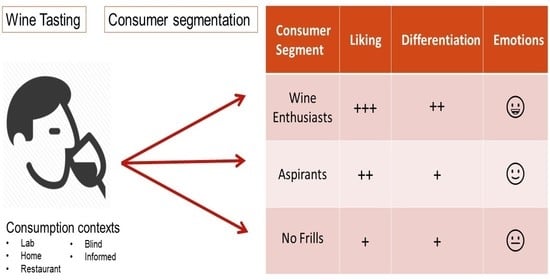Consumption Context Effects on Fine Wine Consumer Segments’ Liking and Emotions
Abstract
1. Introduction
2. Materials and Methods
2.1. FWI and Emotion Scales
2.2. Study 1 (White Wines)
2.2.1. Wine Samples
2.2.2. Tasting Procedure
2.3. Study 2 (Shiraz Wines)
2.3.1. Wine Samples
2.3.2. Consumer Tasting, 3 Trials, 3 Different Contexts (Sensory Lab, Home and Restaurant)
2.4. Data Analyses
3. Results and Discussion
3.1. Fine Wine Segments
3.2. Demographic Composition of the Fine Wine Segments
3.3. Research Question 1: Fine Wine Segments’ Hedonic Responses When Tasting Wine in Different Contexts
3.3.1. Study 1 (White Wines)
3.3.2. Study 2 (Shiraz Wines)
3.4. Research Question 2: Fine Wine Segments’ Emotional Responses When Tasting Wine in Different Contexts
3.4.1. Study 1 (White Wines)
3.4.2. Study 2 (Shiraz)
3.5. Fine Wine Segments’ Mood in Anticipation of Tasting Wines in Different Contexts
4. General Discussion and Conclusions
Author Contributions
Funding
Acknowledgments
Conflicts of Interest
Appendix A
| Connoisseur Dimension |
| I can generally recall the memorable wines that I drink. |
| I keep a record of the wines that I buy. |
| I prefer shopping for and buying wine from specialty outlets. |
| I have a special wine storage space (either at home or elsewhere) that allows me to age my wines and maintain a wine collection. |
| I usually buy at least a half dozen bottles (mixed or same) each time I buy wine. |
| I always check my wine for cork or other taints. |
| I prefer to drink older wines than younger wines. |
| Knowledge Dimension |
| I regularly attend special wine tastings or wine club meetings. |
| I regularly read wine magazines and wine reviews in newspapers. |
| I take more notice of wine related articles in the press and TV than I did two years ago. |
| Being knowledgeable about wine gives me a great deal of satisfaction. |
| I would like to learn more about wine styles and their countries of origin. |
| Provenance Dimension |
| I am choosy when it comes to selecting wines from particular vintages. |
| I often look for rare or scarce wines. |
| For me, the grape variety from which the wine is made is an important consideration. |
| I prefer wines from certain geographical regions. |
| In my wine collection, it is important to have wines from countries other than Australia. |
| When drinking wine, it is important for me to know in which country the wine was made. |
| Moods | C | FWS | C*FWS |
|---|---|---|---|
| p | p | p | |
| Angry | 0.659 | 0.398 | 0.656 |
| Calm | 0.231 | 0.002 | 0.486 |
| Energetic | 0.072 | 0.022 | 0.981 |
| Fearful | 0.003 | 0.052 | 0.848 |
| Happy | <0.001 | <0.001 | 0.913 |
| Loving | 0.001 | 0.006 | 0.524 |
| Sad | 0.879 | 0.309 | 0.530 |
| Tired | 0.843 | 0.231 | 0.975 |
References
- Smith, W.R. Product Differentiation and Market Segmentation as Alternative Marketing Strategies. J. Mark. 1956, 21, 3–8. [Google Scholar] [CrossRef]
- Grunert, K.G.; Perrea, T.; Zhou, Y.; Huang, G.; Sørensen, B.T.; Krystallis, A. Is food-related lifestyle (FRL) able to reveal food consumption patterns in non-Western cultural environments? Its adaptation and application in urban China. Appetite 2011, 56, 357–367. [Google Scholar] [CrossRef] [PubMed]
- Kotler, P.; Brown, L.; Burton, S.; Deans, K.R.; Armstrong, G. Marketing, 8th ed.; Pearson Pretice Hall: Sydney, Australia, 2010. [Google Scholar]
- Wedel, M.; Wagner, A.K. Market Segmentation, 2nd ed.; Springer: New York, NY, USA, 2000. [Google Scholar]
- Johnson, L.W.; Ringham, L.; Jurd, K. Behavioural Segmentation in the Australian Wine Market Using Conjoint Choice Analysis. Int. Mark. Rev. 1991, 8, 26–33. [Google Scholar] [CrossRef]
- McKinna, D.A. Attitudes, Behaviour, Perceptions and Knowledge with Respect to South Australian Wine: A Report on a Qualitative and Quantitative Research Program; Pty. Limited: Melbourne, Austraila, 1996. [Google Scholar]
- Bruwer, J.; Fong, M.; Saliba, A. Perceived risk, risk-reduction strategies (RRS) and consumption occasions. Asia Pac. J. Mark. Logist. 2013, 25, 369–390. [Google Scholar] [CrossRef]
- Johnson, T.E.; Bastian, S.E.P. A fine wine instrument—An alternative for segmenting the Australian wine market. Int. J. Wine Bus. Res. 2015, 27, 182–202. [Google Scholar] [CrossRef]
- Bruwer, J.; Li, E. Domain-specific market segmentation using a latent class mixture modelling approach and wine-related lifestyle (WRL) algorithm. Eur. J. Mark. 2017, 51, 1552–1576. [Google Scholar] [CrossRef]
- Lockshin, L.S.; Spawton, A.L.; Macintosh, G. Using product, brand and purchasing involvement for retail segmentation. J. Retail. Consum. Serv. 1997, 4, 171–183. [Google Scholar] [CrossRef]
- Hall, J.; Lockshin, L. It’s not the consumer, it’s the occasion. Aust. N. Z. Wine Ind. J. 1999, 14, 69–78. [Google Scholar]
- Hall, J.; Winchester, M. An Empirical Confirmation of Segments in the Australian Wine Market. Int. J. Wine Mark. 1999, 11, 19–35. [Google Scholar] [CrossRef]
- Bruwer, J.; Li, E.; Reid, M. Segmentation of the Australian Wine Market Using a Wine-Related Lifestyle Approach. J. Wine Res. 2002, 13, 217–242. [Google Scholar] [CrossRef]
- Johnson, T.E.; Bruwer, J. An empirical confirmation of wine-related lifestyle segments in the Australian wine market. Int. J. Wine Mark. 2003, 15, 5–33. [Google Scholar] [CrossRef]
- Bruwer, J.; Li, E. Wine-Related Lifestyle (WRL) Market Segmentation: Demographic and Behavioural Factors. J. Wine Res. 2007, 18, 19–34. [Google Scholar] [CrossRef]
- Johnson, T.E.; Bastian, S.E.P. A preliminary study of the relationship between Australian wine consumers’ wine expertise and their wine purchasing and consumption behaviour. Aust. J. Grape Wine Res. 2007, 13, 186–197. [Google Scholar] [CrossRef]
- Cox, D. Predicting consumption, wine involvement and perceived quality of Australian red wine. J. Wine Res. 2009, 20, 209–229. [Google Scholar] [CrossRef]
- Bruwer, J. Consumer behaviour insights and wine. In Wine Business Management; Charters, S., Gallo, J., Eds.; Pearson France: Paris, France, 2014; pp. 145–161. [Google Scholar]
- Bruwer, J.; Li, C.; Reid, M. Wine-related lifestyle segmentation of the Australian domestic wine market. Aust. N. Z. Wine Ind. J. 2001, 16, 104–118. [Google Scholar]
- Ahmad, R. Benefit segmentation: A potentially useful technique of segmenting and targeting older consumersrizal ahmad. Int. J. Mark. Res. 2003, 45, 373–388. [Google Scholar] [CrossRef]
- Grunert, K.G.; Brunso, K.; Bisp, S. Food-related life style: Development of a cross-culturally valid instrument for market surveillance. In Values, Lifestyles, and Psychographics; Kahle, L., Chiagouris, L., Eds.; Psychology Press: New York, NY, USA, 1997; pp. 231–246. [Google Scholar]
- Johnson, T.E.; Bruwer, J. Generic Consumer Risk-Reduction Strategies (RRS) in Wine-Related Lifestyle Segments of the Australian Wine Market. Int. J. Wine Mark. 2004, 16, 5–35. [Google Scholar] [CrossRef]
- Bruwer, J.; Chrysochou, P.; Lesschaeve, I. Consumer involvement and knowledge influence on wine choice cue utilisation. Br. Food J. 2017, 119, 830–844. [Google Scholar] [CrossRef]
- Johnson, T.E.; Danner, L.; Bastian, S.E.P. Real World Examples of Wine Market Segments with a Focus on the Australian Market. In Reference Module in Food Science; Elsevier: Amsterdam, The Netherlands, 2018. [Google Scholar] [CrossRef]
- Johnson, T.E.; Danner, L.; Bastian, S.E.P. Consumer Segmentation Methods for the Wine Market. In Reference Module in Food Science; Elsevier: Amsterdam, The Netherlands, 2017; pp. 1–6. [Google Scholar] [CrossRef]
- Bruwer, J.; Roediger, B.B.; Herbst, F. Domain-specific market segmentation: A wine-related lifestyle (WRL) approach. Asia Pac. J. Mark. Logist. 2017, 239, 4–26. [Google Scholar] [CrossRef]
- Verdonk, N.; Ristic, R.; Culbert, J.; Pearce, K.; Wilkinson, K. Understanding Australian Wine Consumers’ Preferences for Different Sparkling Wine Styles. Beverages 2020, 6, 14. [Google Scholar] [CrossRef]
- Jaeger, S.R.; Hort, J.; Porcherot, C.; Ares, G.; Pecore, S.; MacFie, H.J.H. Future directions in sensory and consumer science: Four perspectives and audience voting. Food Qual. Prefer. 2017, 56, 301–309. [Google Scholar] [CrossRef]
- Meiselman, H.L. The future in sensory/consumer research:..............evolving to a better science. Food Qual. Prefer. 2013, 27, 208–214. [Google Scholar] [CrossRef]
- Lattey, K.A.; Bramley, B.R.; Francis, I.L. Consumer acceptability, sensory properties and expert quality judgements of Australian Cabernet Sauvignon and Shiraz wines. Aust. J. Grape Wine Res. 2010, 16, 189–202. [Google Scholar] [CrossRef]
- King, E.S.; Kievit, R.L.; Curtin, C.; Swiegers, J.H.; Pretorius, I.S.; Bastian, S.E.P.; Francis, I.L. The effect of multiple yeasts co-inoculations on Sauvignon Blanc wine aroma composition, sensory properties and consumer preference. Food Chem. 2010, 122, 618–626. [Google Scholar] [CrossRef]
- Desmet, P.M.A.; Schifferstein, H.N.J. Sources of positive and negative emotions in food experience. Appetite 2008, 50, 290–301. [Google Scholar] [CrossRef] [PubMed]
- King, S.C.; Meiselman, H.L.; Hottenstein, A.W.; Work, T.M.; Cronk, V. The effects of contextual variables on food acceptability: A confirmatory study. Food Qual. Prefer. 2007, 18, 58–65. [Google Scholar] [CrossRef]
- Meiselman, H.L. Context: The Effects of Environment on Product Design and Evaluation, 1st ed.; Meiselman, H.L., Ed.; Woodhead Publishing: Duxford, UK, 2019; ISBN 9780128144954. [Google Scholar]
- Bastian, S.E.P.; Danner, L.; Niimi, J.; Ristic, R.; Johnson, T.E. Alcoholic beverages in context. In Context; Meiselman, H.L., Ed.; Woodhead Publishing: Duxford, UK, 2019; pp. 605–630. ISBN 9780128144954. [Google Scholar]
- D’Alessandro, S.; Pecotich, A. Evaluation of wine by expert and novice consumers in the presence of variations in quality, brand and country of origin cues. Food Qual. Prefer. 2013, 28, 287–303. [Google Scholar] [CrossRef]
- Hersleth, M.; Mevik, B.H.; Næs, T.; Guinard, J.X. Effect of contextual factors on liking for wine—Use of robust design methodology. Food Qual. Prefer. 2003, 14, 615–622. [Google Scholar] [CrossRef]
- Kustos, M.; Heymann, H.; Jeffery, D.W.; Goodman, S.; Bastian, S.E.P. Intertwined: What makes food and wine pairings appropriate? Food Res. Int. 2020, 136, 109463. [Google Scholar] [CrossRef]
- Mueller, S.; Osidacz, P.; Francis, I.L.; Lockshin, L. Combining discrete choice and informed sensory testing in a two-stage process: Can it predict wine market share? Food Qual. Prefer. 2010, 21, 741–754. [Google Scholar] [CrossRef]
- Gmuer, A.; Siegrist, M.; Dohle, S. Does wine label processing fluency influence wine hedonics? Food Qual. Prefer. 2015, 44, 12–16. [Google Scholar] [CrossRef]
- Danner, L.; Johnson, T.E.; Ristic, R.; Meiselman, H.L.; Bastian, S.E.P. “I like the sound of that!” Wine descriptions influence consumers’ expectations, liking, emotions and willingness to pay for Australian white wines. Food Res. Int. 2017, 99, 263–274. [Google Scholar] [CrossRef] [PubMed]
- Spinelli, S.; Masi, C.; Dinnella, C.; Zoboli, G.P.; Monteleone, E. How does it make you feel? A new approach to measuring emotions in food product experience. Food Qual. Prefer. 2014, 37, 109–122. [Google Scholar] [CrossRef]
- Ng, M.; Chaya, C.; Hort, J. The influence of sensory and packaging cues on both liking and emotional, abstract and functional conceptualisations. Food Qual. Prefer. 2013, 29, 146–156. [Google Scholar] [CrossRef]
- Niimi, J.; Danner, L.; Bastian, S.E.P. Wine leads us by our heart not our head: Emotions and the wine consumer. Curr. Opin. Food Sci. 2019. [Google Scholar] [CrossRef]
- Jiang, W.; Niimi, J.; Ristic, R.; Bastian, S.E.P. The effects of immersive context and wine flavor on consumer wine flavor perception and elicited emotions. Am. J. Enol. Vitic. 2017, 68, 1–10. [Google Scholar] [CrossRef]
- Calvo-Porral, C.; Lévy-Mangin, J.-P.; Ruiz-Vega, A. An emotion-based typology of wine consumers. Food Qual. Prefer. 2020, 79, 103777. [Google Scholar] [CrossRef]
- Danner, L.; Ristic, R.; Johnson, T.E.; Meiselman, H.L.; Hoek, A.C.; Jeffery, D.W.; Bastian, S.E.P. Context and wine quality effects on consumers’ mood, emotions, liking and willingness to pay for Australian Shiraz wines. Food Res. Int. 2016, 89, 254–265. [Google Scholar] [CrossRef]
- Parr, W.V.; Heatherbell, D.; White, K.G. Demystifying wine expertise: Olfactory threshold, perceptual skill and semantic memory in expert and novice wine judges. Chem. Senses 2002, 27, 747–755. [Google Scholar] [CrossRef]
- Lawless, H.T.; Heymann, H. Sensory Evaluation of Food, Principles and Practices, 2nd ed.; Springer: New York, NY, USA, 2010; ISBN 9781441964878. [Google Scholar]
- Dunphy, R.; Lockshin, L. A history of the Australian wine show system. J. Wine Res. 1998, 9, 87–105. [Google Scholar] [CrossRef]
- Mayer, J.D.; Gaschke, Y.N. The experience and meta-experience of mood. J. Personal. Soc. Psychol. 1988, 55, 102–111. [Google Scholar] [CrossRef]
- Thach, L.; Olsen, J. Profiling the high frequency wine consumer by price segmentation in the US market. Wine Econ. Policy 2015, 4, 53–59. [Google Scholar] [CrossRef]
- King, E.S.; Johnson, T.E.; Bastian, S.E.P.; Osidacz, P.; Leigh Francis, I. Consumer liking of white wines: Segmentation using self-reported wine liking and wine knowledge. Int. J. Wine Bus. Res. 2012, 24, 33–46. [Google Scholar] [CrossRef]
- Charters, S.; Pettigrew, S. How effectively do we communicate about wine? Steve Charters. In Proceedings of the 3rd International Wine Business Research Conference, Montpellier, France, 6–8 July 2006. [Google Scholar]
- Mueller, S.; Lockshin, L.; Saltman, Y.; Blanford, J. Message on a bottle: The relative influence of wine back label information on wine choice. Food Qual. Prefer. 2010, 21, 22–32. [Google Scholar] [CrossRef]
- Johnson, T.E. Regionality and Drivers of Consumer Liking: The Case of Australian Shiraz in the Context of the Australian Domestic Wine Market. Ph. D. Thesis, The University of Adelaide, Adelaide, Australia, 2013. [Google Scholar]
- Niimi, J.; Danner, L.; Li, L.; Bossan, H.; Bastian, S.E.P. Wine consumers’ subjective responses to wine mouthfeel and understanding of wine body. Food Res. Int. 2017, 99, 115–122. [Google Scholar] [CrossRef]
- Mora, M.; Urdaneta, E.; Chaya, C. Effect of personality on the emotional response elicited by wines. Food Qual. Prefer. 2019, 76, 39–46. [Google Scholar] [CrossRef]
- De Pelsmaeker, S.; Schouteten, J.; Gellynck, X. The consumption of flavored milk among a children population. The influence of beliefs and the association of brands with emotions. Appetite 2013, 71, 279–286. [Google Scholar] [CrossRef]
- Dorado, R.; Pérez-Hugalde, C.; Picard, A.; Chaya, C. Influence of first position effect on emotional response. Food Qual. Prefer. 2016, 49, 189–196. [Google Scholar] [CrossRef]
- John, O.P.; Srivastava, S. The Big Five trait taxonomy: History, measurement, and theoretical perspectives. In Handbook of Personality: Theory and Research, 2nd ed.; Perin, L.A., John, O.P., Eds.; Guilford Press: New York, NY, USA, 1999; pp. 102–138. [Google Scholar]
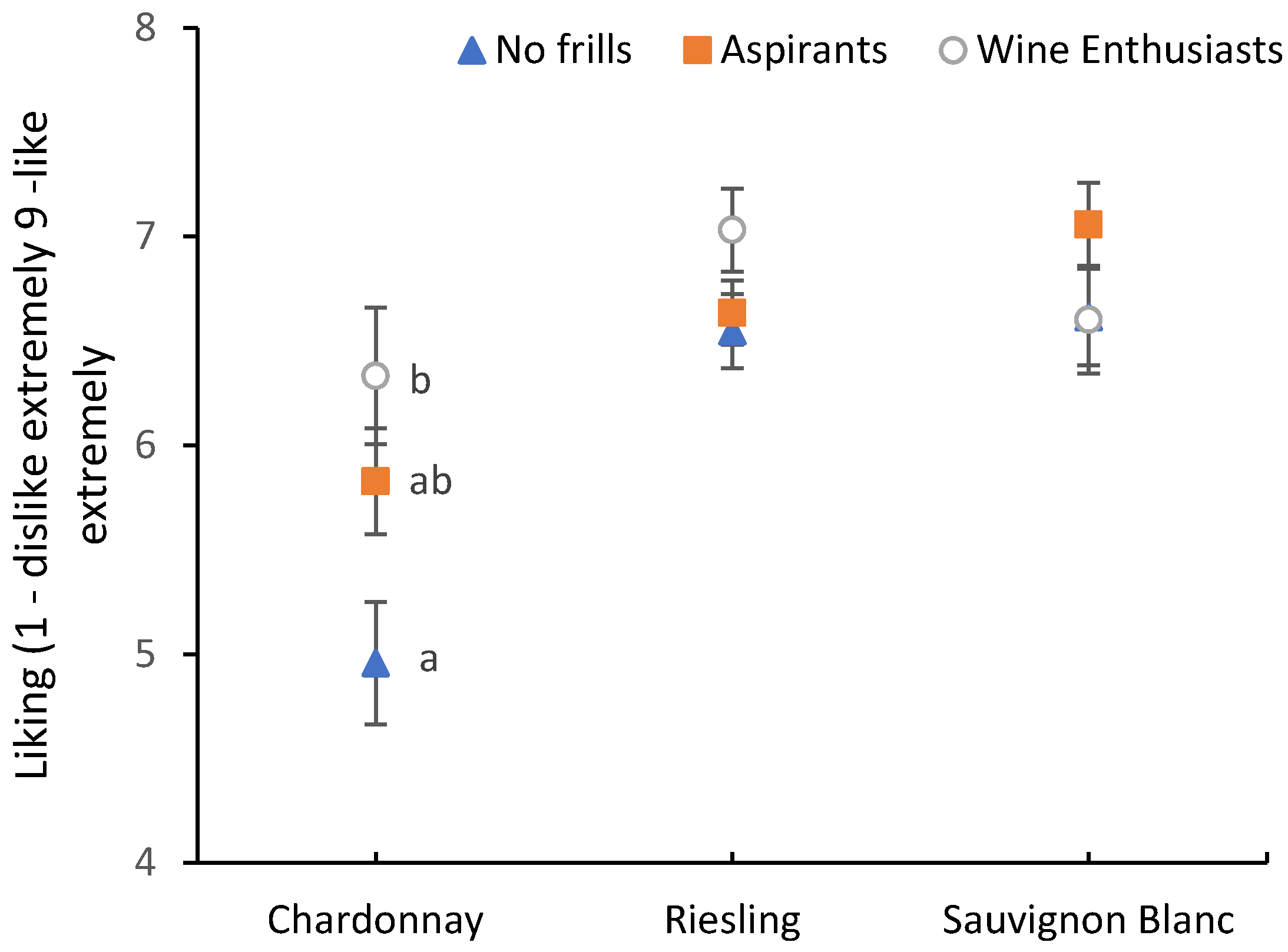
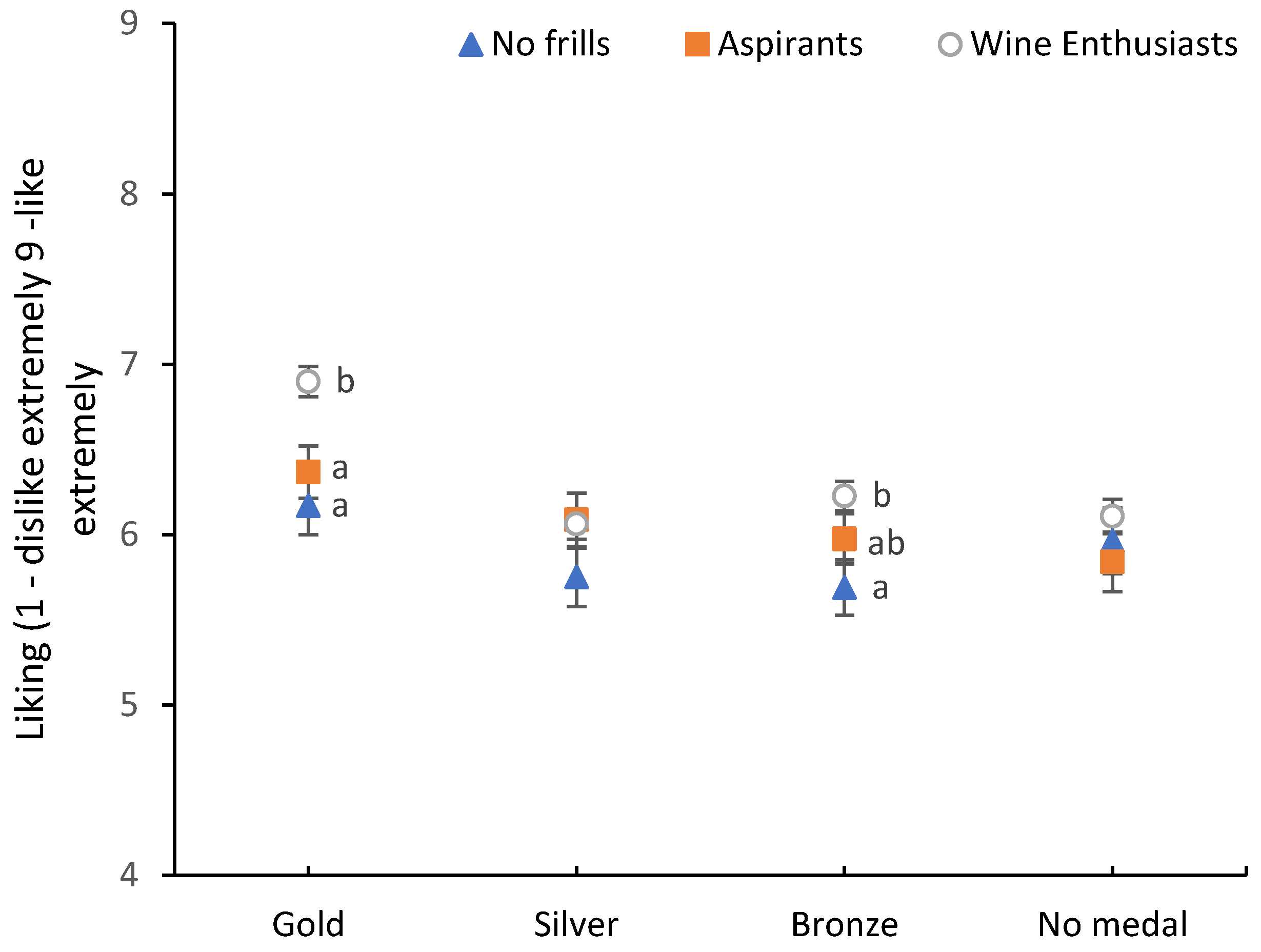
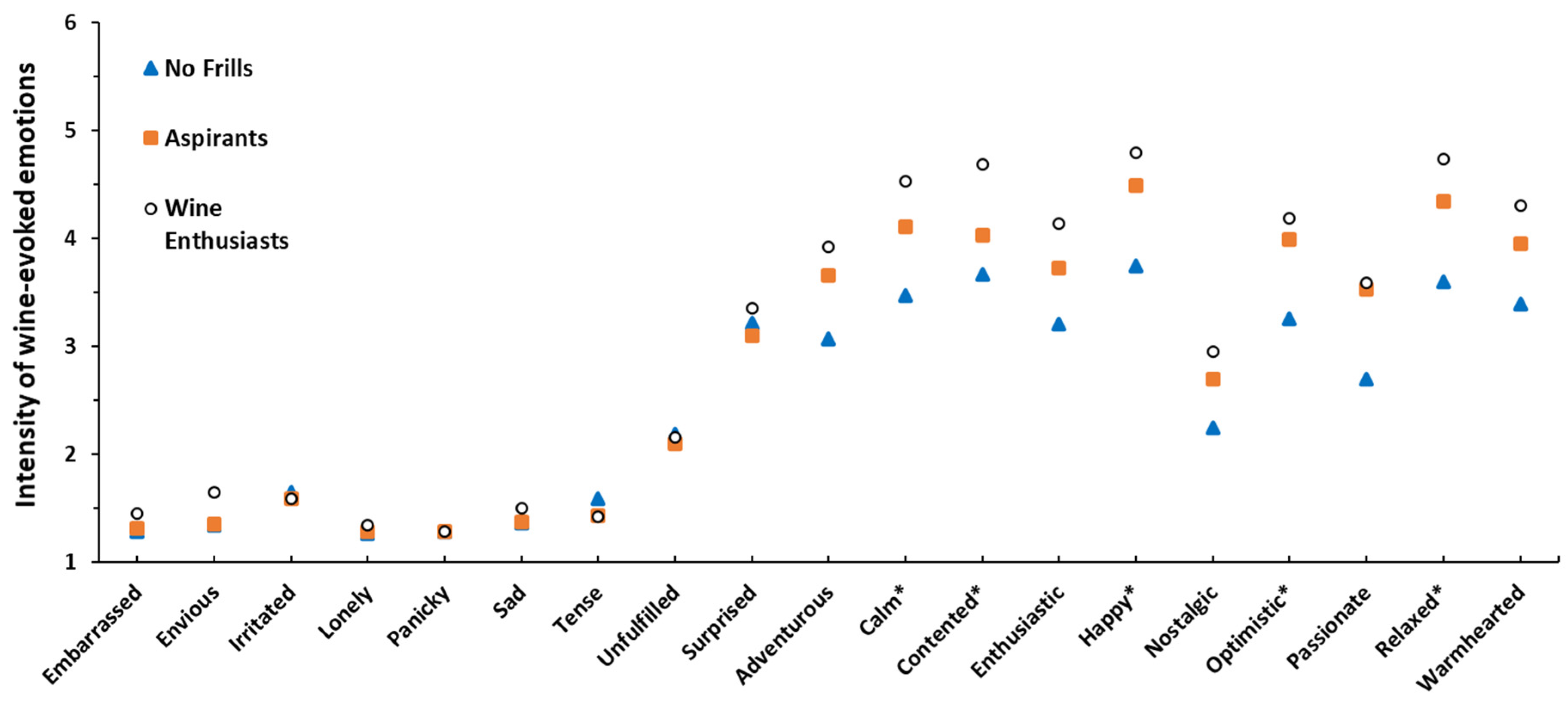
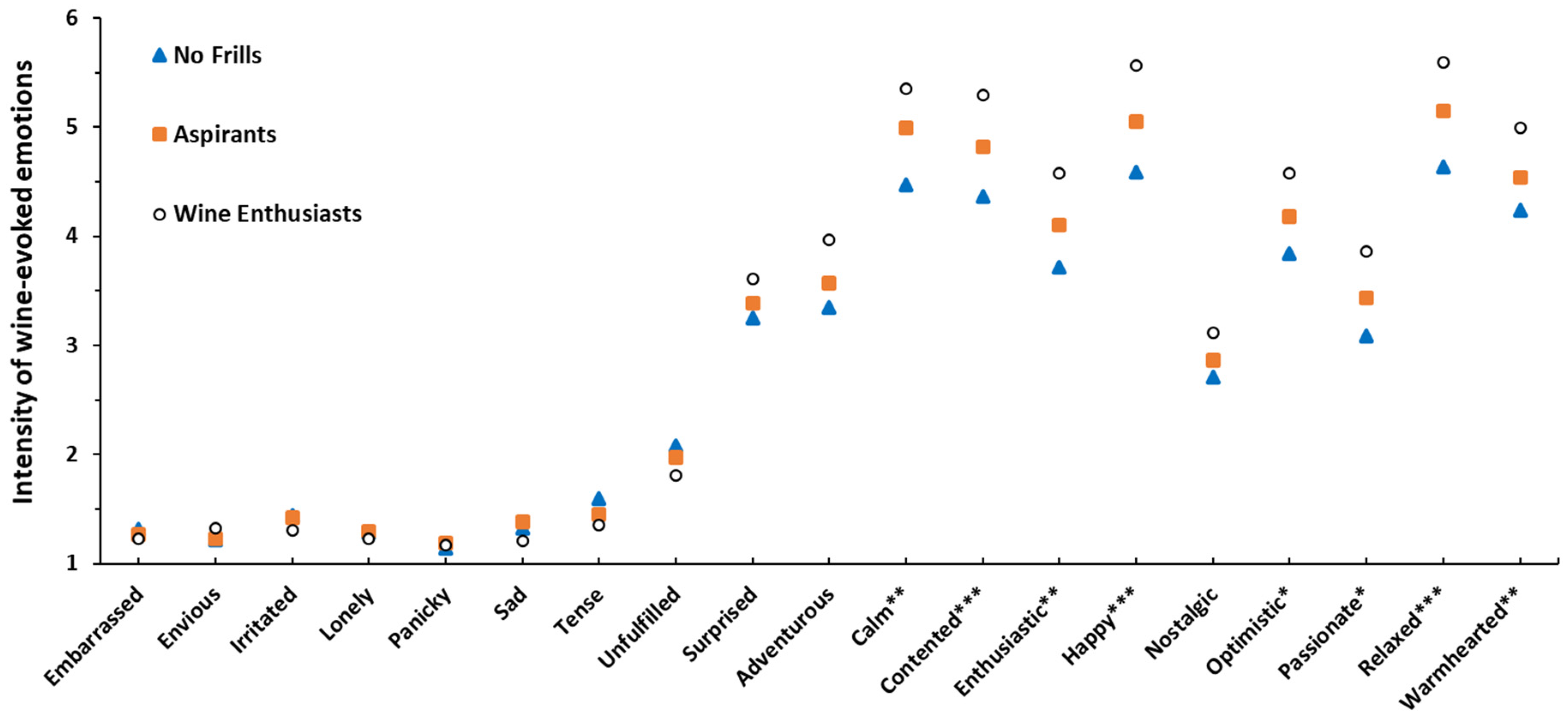
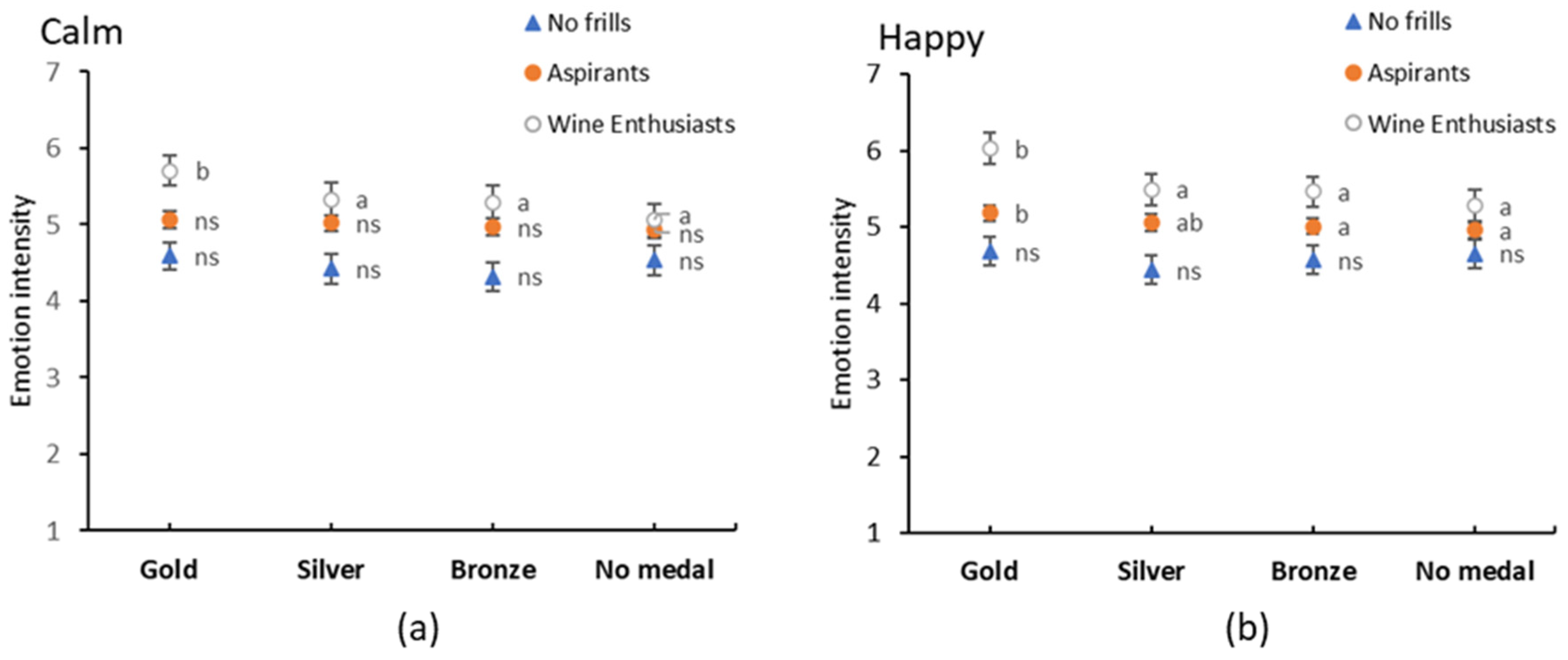
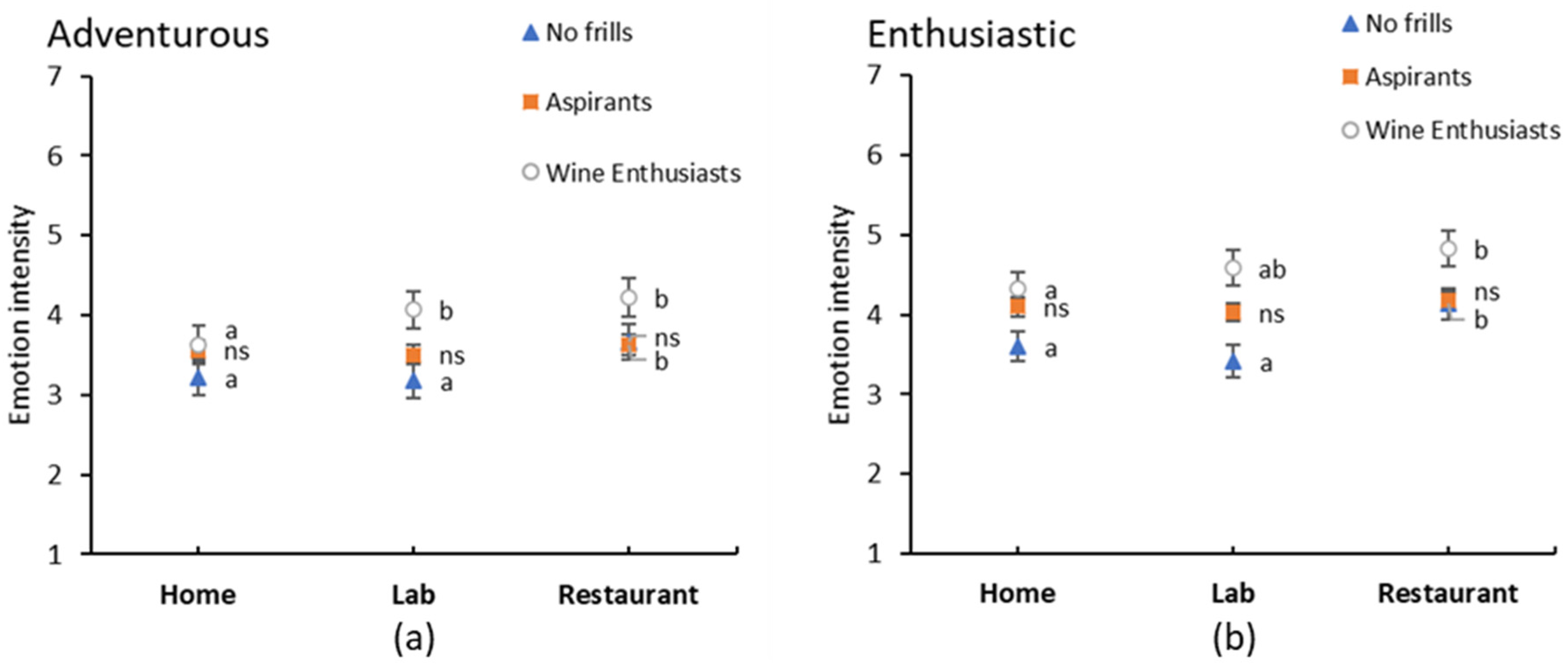
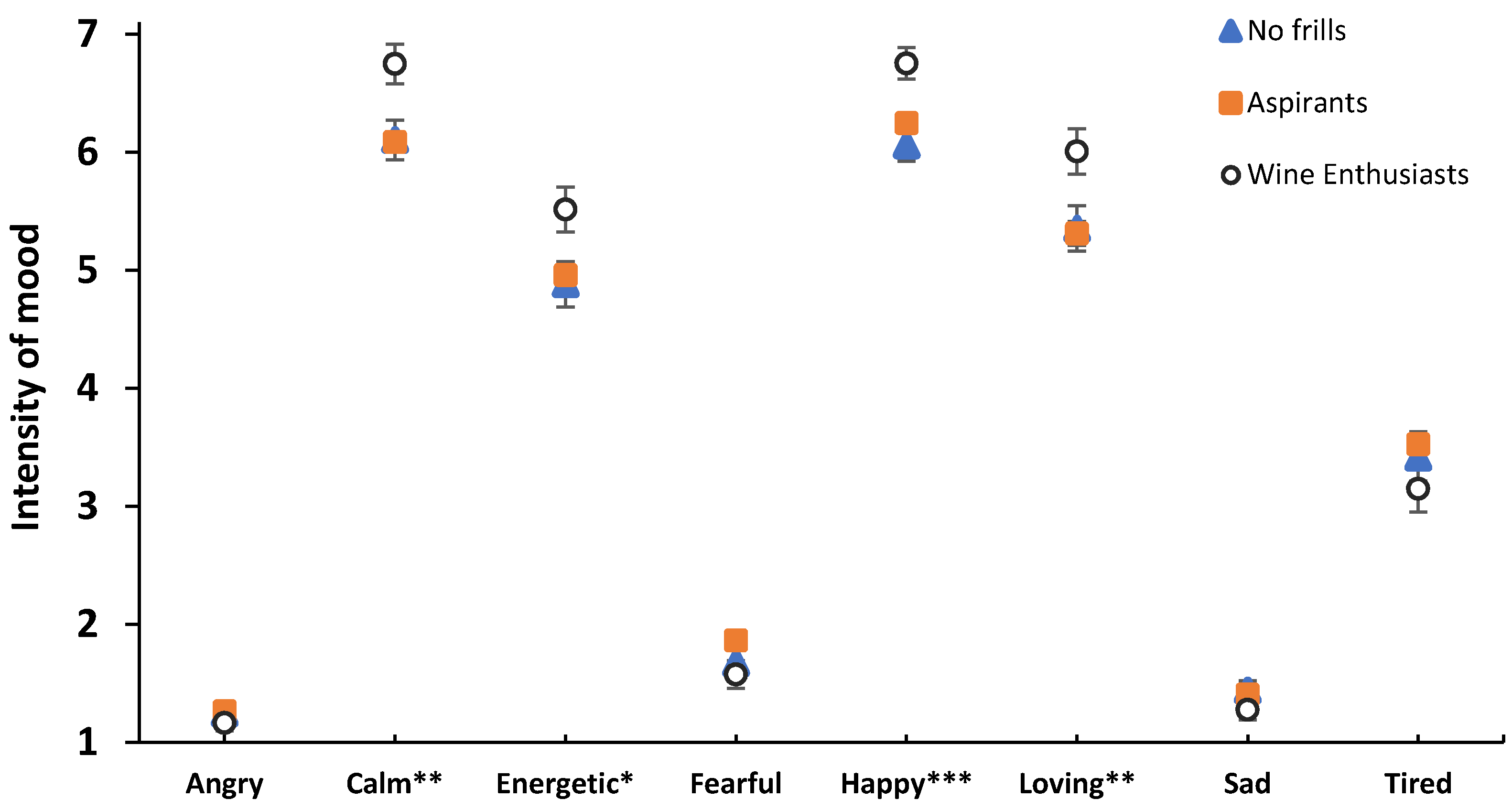
| Fine Wine Consumer Segment | ||||||
|---|---|---|---|---|---|---|
| Study 1 (n = 122) | Study 2 (n = 346) | |||||
| No Frills | Aspirants | Wine Enthusiasts | No Frills | Aspirants | Wine Enthusiasts | |
| Dimension | n = 39; 32% | n = 52; 43% | n = 31; 25% | n = 72; 21% | n = 215; 62% | n = 59; 17% |
| Connoisseur | 4.5 a | 5.8 b | 7.0 c | 4.2 a | 5.7 b | 7.2 c |
| Knowledge | 4.0 a | 5.9 b | 7.3 c | 3.8 a | 5.3 b | 7.2 c |
| Provenance | 4.5 a | 5.8 b | 6.5 c | 3.9 a | 5.6 b | 6.9 c |
| Fine Wine Consumer Segment | ||||||||
|---|---|---|---|---|---|---|---|---|
| Study 1 | Study 2 | |||||||
| No Frills | Aspirants | Wine Enthusiasts | Total | No Frills | Aspirants | Wine Enthusiasts | Total | |
| n = 39; 32% | n = 52; 43% | n = 31; 25% | n = 122 | n = 72; 21% | n = 215; 62% | n = 59; 17% | n = 346 | |
| [%] | [%] | [%] | [%] | [%] | [%] | [%] | [%] | |
| Gender | ||||||||
| Male | 46.3 | 41.5 | 53.1 | 46.0 | 54.2 | 55.3 | 62.7 | 56.4 |
| Female | 53.7 | 58.5 | 46.9 | 54.0 | 45.8 | 44.7 | 37.3 | 43.6 |
| Age | ||||||||
| 18–34 | 17.1 | 26.4 | 15.6 | 20.6 | 25.0 | 20.0 | 13.6 | 19.9 |
| 35–49 | 31.7 | 18.9 | 15.6 | 22.2 | 29.2 | 29.8 | 22.0 | 28.3 |
| 50–64 | 29.3 | 34.0 | 46.9 | 35.7 | 37.5 | 34.0 | 40.7 | 35.8 |
| 65+ | 22.0 | 20.8 | 21.9 | 21.4 | 8.3 a | 16.3 ab | 23.7 b | 15.9 |
| Education | ||||||||
| No tertiary | 48.8 | 34.0 | 53.1 | 43.6 | 50.0 | 40.9 | 49.2 | 44.2 |
| Bachelor degree | 19.5 | 30.2 | 21.9 | 24.6 | 29.2 | 30.7 | 23.7 | 29.2 |
| Postgraduate degree | 31.7 | 35.8 | 25.0 | 31.8 | 20.8 | 28.4 | 27.1 | 26.6 |
| Household Income [AUD] | ||||||||
| <50,000 | 14.6 | 18.9 | 21.9 | 18.3 | 19.4 | 13.0 | 20.3 | 15.6 |
| 50,001–100,000 | 41.5 | 45.3 | 37.5 | 42.0 | 40.3 | 40.5 | 35.6 | 39.6 |
| 100,001–200,000 | 34.1 | 26.4 | 31.3 | 30.2 | 38.9 | 39.5 | 35.6 | 38.7 |
| >200,000 | 9.8 | 9.4 | 9.4 | 9.5 | 1.4 | 7.0 | 8.5 | 6.1 |
| General Wine Consumption Frequency | ||||||||
| Few times per week | 65.9 a | 69.8 ab | 87.5 b | 73.0 | 61.1 a | 75.8 b | 78.0 b | 73.1 |
| Once a week | 12.2 | 17.0 | 9.4 | 13.5 | 22.2 | 16.3 | 16.9 | 17.6 |
| Once every 2 weeks | 14.6 | 11.3 | 3.1 | 10.3 | 13.9 b | 5.1 a | 3.4 a | 6.6 |
| Once a month | 7.3 | 1.9 | 0.0 | 3.2 | 2.8 | 2.8 | 1.7 | 2.6 |
| Average Spent for a Bottle of Wine [AUD] | ||||||||
| For home consumption | 15.3 a | 18.8 b | 17.4 a b | 17.1 a | 18.8 a | 23.2 b | ||
| A a restaurant | 35.7 a† | 39.1 a b† | 42.3 b† | 33.8 a | 37.8 b | 44.1 c | ||
| For a special occasion | 34.0 a | 38.3 a b | 41.5 b | NA ‡ | NA ‡ | NA ‡ | ||
| S | I | FWS | S*FWS | I*FWS | S*I | S*I*FWS | |
|---|---|---|---|---|---|---|---|
| p | p | p | p | p | p | p | |
| Liking | <0.001 | <0.001 | 0.016 | 0.027 | 0.598 | 0.715 | 0.430 |
| Adventurous | <0.001 | 0.001 | 0.096 | 0.296 | 0.284 | 0.917 | 0.651 |
| Calm | 0.002 | 0.007 | 0.019 | 0.428 | 0.321 | 0.597 | 0.590 |
| Contented | <0.001 | 0.009 | 0.022 | 0.112 | 0.796 | 0.255 | 0.170 |
| Embarrassed | 0.004 | 0.060 | 0.464 | 0.738 | 0.607 | 0.891 | 0.180 |
| Enthusiastic | <0.001 | 0.001 | 0.066 | 0.059 | 0.185 | 0.042 | 0.742 |
| Envious | 0.633 | 0.662 | 0.208 | 0.609 | 0.002 | 0.110 | 0.772 |
| Happy | <0.001 | <0.001 | 0.017 | 0.320 | 0.091 | 0.555 | 0.788 |
| Irritated | <0.001 | 0.011 | 0.927 | 0.149 | 0.220 | 0.601 | 0.115 |
| Lonely | 0.402 | 0.569 | 0.871 | 0.767 | 0.645 | 0.047 | 0.714 |
| Nostalgic | 0.886 | <0.001 | 0.150 | 0.100 | 0.094 | 0.480 | 0.777 |
| Optimistic | 0.008 | <0.001 | 0.045 | 0.411 | 0.088 | 0.629 | 0.660 |
| Panicky | 0.008 | 0.454 | n.a. | 0.296 | 0.269 | 0.872 | 0.074 |
| Passionate | 0.003 | <0.001 | 0.052 | 0.147 | 0.401 | 0.700 | 0.186 |
| Relaxed | 0.001 | 0.004 | 0.012 | 0.103 | 0.210 | 0.495 | 0.216 |
| Sad | <0.001 | 0.458 | 0.645 | 0.835 | 0.935 | 0.647 | 0.795 |
| Surprised | 0.129 | 0.024 | 0.791 | 0.693 | 0.387 | 0.082 | 0.202 |
| Tense | <0.001 | 0.009 | 0.520 | 0.245 | 0.650 | 0.560 | 0.678 |
| Unfulfilled | <0.001 | <0.001 | 0.935 | 0.106 | 0.955 | 0.687 | 0.825 |
| Warm-hearted | 0.004 | <0.001 | 0.067 | 0.100 | 0.339 | 0.891 | 0.684 |
| Q | C | FWS | Q*FWS | C*FWS | C*Q | Q*C*FWS | |
|---|---|---|---|---|---|---|---|
| p | p | p | p | p | p | p | |
| Liking | <0.001 | 0.750 | 0.023 | 0.114 | 0.749 | 0.219 | 0.548 |
| Adventurous | 0.305 | <0.001 | 0.095 | 0.721 | 0.019 | 0.059 | 0.156 |
| Calm | <0.001 | <0.001 | 0.002 | 0.032 | 0.576 | 0.476 | 0.491 |
| Contented | <0.001 | 0.005 | <0.001 | 0.194 | 0.481 | 0.069 | 0.822 |
| Embarrassed | 0.553 | 0.047 | 0.585 | 0.001 | 0.850 | 0.031 | 0.767 |
| Enthusiastic | 0.001 | <0.001 | 0.004 | 0.240 | 0.008 | 0.354 | 0.999 |
| Envious | 0.891 | 0.685 | 0.473 | 0.538 | 0.449 | 0.255 | 0.124 |
| Happy | <0.001 | <0.001 | <0.001 | 0.022 | 0.075 | 0.227 | 0.831 |
| Irritated | 0.172 | 0.276 | 0.376 | 0.704 | 0.428 | 0.227 | 0.512 |
| Lonely | 0.763 | 0.347 | 0.684 | 0.135 | 0.262 | 0.242 | 0.512 |
| Nostalgic | 0.001 | 0.348 | 0.300 | 0.067 | 0.501 | 0.813 | 0.737 |
| Optimistic | 0.016 | 0.002 | 0.024 | 0.209 | 0.260 | 0.125 | 0.305 |
| Panicky | 0.612 | 0.736 | 0.716 | 0.885 | 0.953 | 0.887 | 0.912 |
| Passionate | <0.001 | 0.011 | 0.029 | 0.524 | 0.667 | 0.872 | 0.995 |
| Relaxed | 0.001 | <0.001 | <0.001 | 0.300 | 0.364 | 0.547 | 0.649 |
| Sad | 0.576 | 0.561 | 0.131 | 0.823 | 0.661 | 0.867 | 0.806 |
| Surprised | <0.001 | 0.534 | 0.382 | 0.148 | 0.330 | 0.144 | 0.561 |
| Tense | 0.246 | 0.002 | 0.077 | 0.907 | 0.669 | 0.909 | 0.431 |
| Unfulfilled | 0.103 | 0.302 | 0.265 | 0.138 | 0.652 | 0.708 | 0.351 |
| Warm-hearted | <0.001 | <0.001 | 0.009 | 0.101 | 0.516 | 0.793 | 0.658 |
Publisher’s Note: MDPI stays neutral with regard to jurisdictional claims in published maps and institutional affiliations. |
© 2020 by the authors. Licensee MDPI, Basel, Switzerland. This article is an open access article distributed under the terms and conditions of the Creative Commons Attribution (CC BY) license (http://creativecommons.org/licenses/by/4.0/).
Share and Cite
Danner, L.; Johnson, T.E.; Ristic, R.; Meiselman, H.L.; Bastian, S.E.P. Consumption Context Effects on Fine Wine Consumer Segments’ Liking and Emotions. Foods 2020, 9, 1798. https://doi.org/10.3390/foods9121798
Danner L, Johnson TE, Ristic R, Meiselman HL, Bastian SEP. Consumption Context Effects on Fine Wine Consumer Segments’ Liking and Emotions. Foods. 2020; 9(12):1798. https://doi.org/10.3390/foods9121798
Chicago/Turabian StyleDanner, Lukas, Trent E. Johnson, Renata Ristic, Herbert L. Meiselman, and Susan E.P. Bastian. 2020. "Consumption Context Effects on Fine Wine Consumer Segments’ Liking and Emotions" Foods 9, no. 12: 1798. https://doi.org/10.3390/foods9121798
APA StyleDanner, L., Johnson, T. E., Ristic, R., Meiselman, H. L., & Bastian, S. E. P. (2020). Consumption Context Effects on Fine Wine Consumer Segments’ Liking and Emotions. Foods, 9(12), 1798. https://doi.org/10.3390/foods9121798





